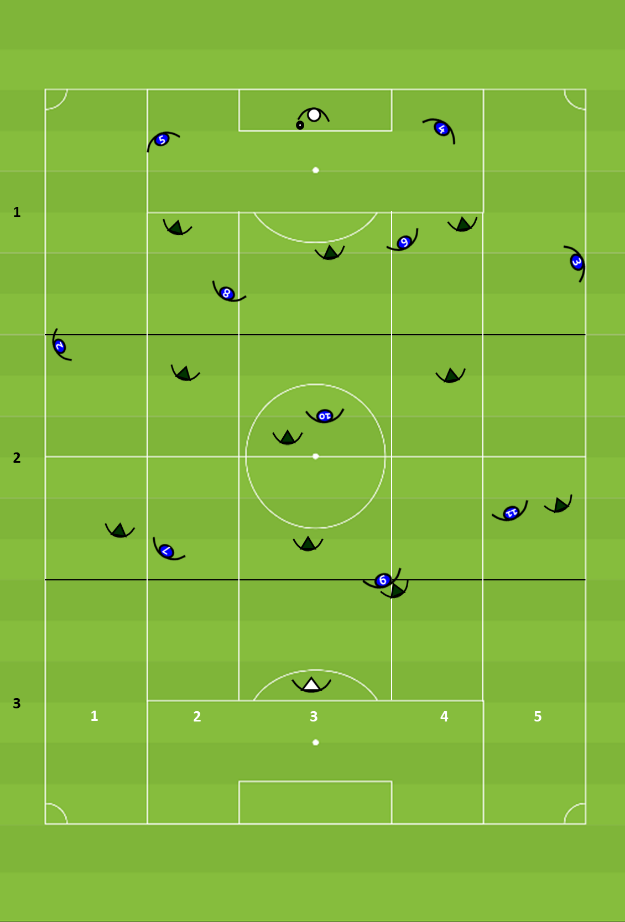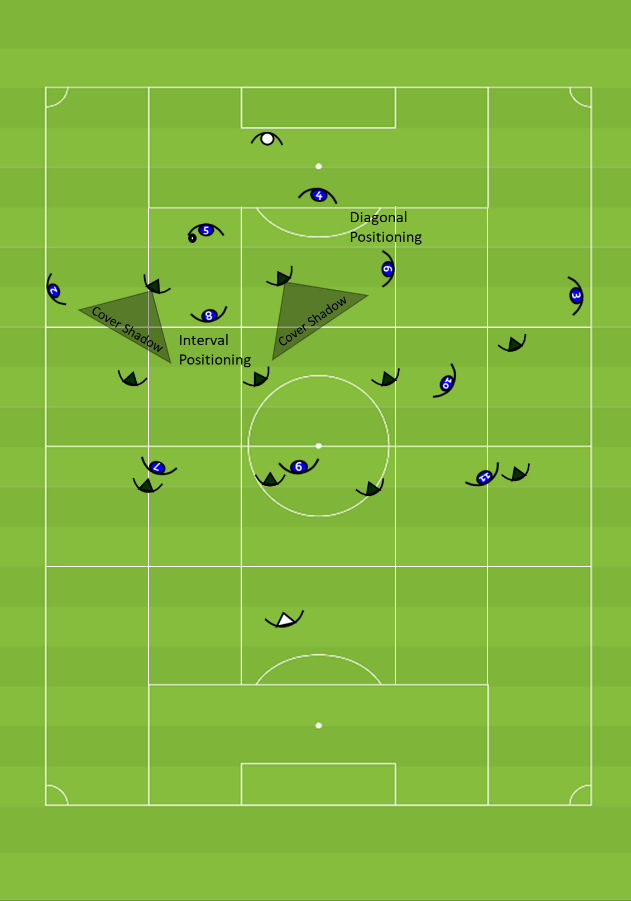Indian Football Coaches Saksham Kakkar and Dipankur Sharma have in detail dissected ‘Build-Up’. Part 1 covered: Origins of the build up; Definition of a build up; Why do teams build up?
This piece will cover:
- Principles
- Patterns
Principles:
As a fan trying to understand build-up play or a coach wanting to implement this into their team’s style of play, it is important to understand the basic principles that are fundamentally required for any team to progress with the ball, through the thirds. It is under the ambit of these principles that coaches can implement their own ideas and innovations to achieve their goal of successfully progressing play from the defensive to the attacking third.
1)Width and Depth (Occupation of Space)
To start, we breakdown the pitch into five zones vertically (two wide, two half spaces, and the central) and 3 thirds horizontally (defensive, midfield and attacking). When a team is looking to build-up play, it is important that they occupy all the spaces either positionally or by arrival (dynamic).
Advantage: By positioning players in all five zones (to provide width) and three thirds (depth), the team ensures that they have multiple passing options available at different angles (triangulations). This in turn commits more defenders from the opposition, to the press, as they have more passing options to block.
In a situation where a team does not follow this principle, it becomes easy for the defending team to make the play predictable and press the attackers to win the ball.

Sub-principles involved:
a. Connecting attackers: Teammates position themselves in a way that the on-ball player can find them with his pass. Distance between the players varies according to the game idea. Lesser distance leads to quick passes and combinations while more distance can allow the player more time on the ball.
b. Triangulation: The off-ball attackers need to create open passing lines (minimum two options) for the on-ball player to reduce the predictability of the attack. The more passing options available for the player the more difficult it is for the defenders to press.
c. Spatial Awareness: Players need to be aware where the space is available on the pitch. Depending on the game idea, this space can be occupied positionally or by arrival.
2) Positioning :
As a continuation of the previous point, the players need to position themselves in a way that they can gather information on the pitch (space, opponents, teammates, etc.) to progress the ball forward. According to the game idea, the positioning of the players changes in order to achieve the desired objective.
Advantage: With the aim of the build-up being, to progress the ball to the opposition half with an advantage, the attacking team positions it’s players in a way that they can create the necessary superiority to break the opponent’s defensive lines. This includes dynamic occupation of favourable spaces on the pitch and making proactive and reactive movements according to the opponent’s press.

Sub-principles involved:
a. Positioning on different lines: The supporting players should position themselves diagonally to the on-ball player, on different lines (both vertically and horizontally) and provide an option for the team (either with the first pass or the second).
b. Gather Maximum Information: Receiving player to have an open body shape and be aware of his teammates and opponents around him before receiving. Based on this information, he may receive the ball with the back foot (space to move into) or front foot (defender close to the player).
c. Diagonal Support: By positioning yourself in relation to the defender (on the same line as his shoulder) the player creates an opportunity to break that line of press with his first touch. Body shape of the receiver and first touch essential for this to be completed successfully.
d. Interval positioning: The attacker can also position himself between two lines of defence (midfield and forward or defensive and midfield) or in the space between two opponents. This ensures that the player occupies multiple opponents at the same time which may lead to the defenders compressing in that area of the pitch (leaving more space for the attacking team elsewhere) or a through ball being played to this player between the lines.
e. Cover Shadow: This is the space that is left behind the pressing defender. Supporting players need to ensure that they move out of the cover shadow of the pressing player to provide an option to the on-ball player.
f. Counter Pressing: While progressing play forward, the team needs to accept that at times, the build-up would not be successfully completed. For this reason, they need to position players behind the ball to counter press in a situation of ball loss.
3) Rotation:
To destabilise the opposition shape and create space for yourself or your teammates, the attackers can rotate positions with teammates on the same line (midfielders switching with each other) or on different lines (midfielder switching position with a centre back or fullback). The objective of this principle is to disorganise the opponent and create space to progress the attack.
Advantage: Players rotating their position forces the defenders to make a decision between following the attacker, which could create space for another player or to cover the space, in which case the attacking team has a free man during the build-up. Vacating your position (moving out of your area) can drag the defender out from that position as well, freeing up space for the on-ball player to play grounded second line passes.
Sub-principles involved:
a. Dynamic Movements: Players occupy space dynamically and change position according to ball, teammates, space and opponents.
b. Opposite Movements: Players use triggers from their teammates to make a run opposite to their teammate. The objective is to drag your defender with you while creating space for your teammate to exploit.
c. Check-in, check-out: Supporting players make movements with an objective to destabilize the defender and drag him away from favourable spaces which they or their teammates can use to progress play.
d. Third man run: One of the most effective ways to use a spatial advantage, third man run focuses on attracting defenders towards the ball before playing a pass into space for a teammate.
4) Superiorities:
As discussed earlier in the article, teams can create superiorities in the form of numerical, positional, qualitative, dynamic and socio effective. Creating a form or a combination of different superiorities is the basis on which teams progresses their attack. Teams can also use inferiorities to create superiorities e.g. creating an under-load situation (numerical) to progress with a dynamic superiority. The team building-up has to recognise on the pitch, or pre-determine what kind of superiorities they wish to create and make particular actions to execute the same.
Advantage: Creating superiorities ensures that the team builds play with an advantage and the chances of losing the ball is reduced. Creating superiorities can also force the opposition to commit more defenders into that part of the pitch, thereby leaving space in other parts.
Sub-principles involved:-
a. Combination Play: This can be done in the form of a ‘one-two’ pass, a ‘wall pass’ or a ‘lay off’. Players pass the ball and move dynamically to occupy new spaces on the pitch.
b. Third man pass: Players connecting to pass the ball to a teammate in an advantageous position. Usually used to shift the opponents and pass the ball to a player with more time, space or a better position.
c. Driven Pass: While playing a long pass, there is an advantage if it is played with pace (driven) when possible over a lobbed pass. Otherwise, the defending team may be able to shift and close down the space. In a situation where the player would need time to reach the target space, the team can prioritize a lobbed pass.
d. Switch Play: The objective of this sub principle is to shift the opposition onto one side of the pitch to create space on the other side. Teams can create spatial, numerical and/or qualitative superiorities by switching the attack.
e. Recognising bonds between teammates: As players spend a lot of time on and off the pitch together, some develop a higher understanding of each other’s movements. This can utilized by the team while building up their attack (eg. Messi and Alves/Alba)
f. Continuation of run: After passing the players should continue their run to be further involved in the attacking play. This can help the team in creating overloads and disbalance the opposition shape. This sub-principle, although important, is dependent on the position of the player (on the pitch), role in the team and position of teammates and opponents around. At times the player may need to hold his position to protect space behind.
g. Quality of Pass: This includes the weight of the pass, played to the correct foot of the teammate (according to the press).
5) Creating Space:
An attacker in space, has the time to pick multiple options (switch play, dribble, through ball, etc.) with the ball at his feet. It makes the next move of the team unpredictable for the opponents. That is why the principle of creating space is pivotal to a team’s build up play. The attacking team can organise their build up play to either create space between the opposition lines or behind their defensive line.
Advantage: Creating space between the opposition lines gives the on-ball player more time to pick out his next option. The team can use this opportunity to, change the direction of the attack (isolate the far side opponent with switch play), play a through ball/long ball to a player making a run behind the opponents defensive line, etc.
Sub-principles involved:-
a. Dismarking: The supporting player needs to time his movements in a way that he can move away from the defender to create space (for himself or his teammates) when there is opportunity to receive a pass. This is usually achieved by performing a check-in check-out movement by the supporting player.
b. Dynamic Occupation of Space: Players position themselves on the pitch in a way that, certain spaces are left free to be occupied ‘dynamically’, when the pass is played into that space. Players receive the pass by arriving into that space instead of starting from there.
c. Combination play, Third man pass and third man run are some of the other sub-principles used by teams to create space between or behind the defensive line of the opponents.
6) Fixing:
Fixing, as the term suggests, means to, ensure that the opponent (or opponents) are stuck in that position and do not shift to cover any other space or attacker. To facilitate the build-up, the attacking team can either fix the opponent to one side of the pitch, to switch the ball and take advantage of the spatial and/or numerical superiority of the other side. Or use it at a more micro level where an attacker fixes an individual opponent by dribbling towards him and creating a superiority (numerical, qualitative etc.) around him to progress.
Advantage: The objective behind fixing opponents is to create and/or maintain superiorities for the team. The action ensures that the opponents are stuck to their position or their side of the pitch and the attackers can progress forward with an advantage.
Sub-principles involved:
a. Control the Pace: Player to fix an opponent by slowing down or pausing the attack. This can lead to a defender pressing the player, leaving space behind for the attacking team to exploit. This action also buys time for the teammates to occupy favourable spaces on the pitch.
b. Bounce Pass: A team uses bounce passes to attract opponents towards them (bait) by playing multiple passes between teammates on the same line. When the defenders try to press, it creates space behind them for the attackers to exploit.
c. Flatten the Press: The objective of this sub-principle is to create space between the lines for the attacking team. The team can use bounce passes or a dribble to attract multiple defenders towards them which creates the space between the lines for their teammates to exploit.
d. Fixing “Off the ball”: Supporting attackers can fix defenders by making runs which are visible to them. The objective of this action can be to drag them away from a particular space or teammate, or to destabilise their defensive shape.
7) Progress with an advantage:
This last principle is a culmination of those before it and talks about the decision the team and individual players have to make about, progressing the ball forward. The players need to identify individual situations on the pitch, recognise if they can create a superiority over the opposition players and then progress the play forward. In a situation where no superiority is visible, the team can recycle the ball in an attempt to destabilize the opponent and create an advantage.
Advantage: A good build-up is one in which the team enters the opponents half with a superiority. This increases the chances of the attack leading to a goal-scoring opportunity.
Sub-principles involved:-
a. Ball Circulation: Players circulate the ball in an attempt to destabilize the opposition shape and open spaces to attack.
b. Creating Multiple Options: Supporting players need to be positioned in all directions around the on-ball player. Each option provides a different advantage, eg. Passing back can help push the opposition further up the field thereby creating space between the lines.
c. Emergency exit: In a situation where the team is unable to progress the ball forward (due to high pressure or defensive shape), an extra attacker should drop to provide an extra passing exit option for the team.
d. Visual Fakes: Players use visual fakes by positioning their body in a way that the defender expects and predicts the ball to be played in a certain space and starts moving accordingly. The player then takes advantage of that movement of the defender by moving the ball into the space vacated (Thiago Alcantara uses this sub-principle often while receiving the ball from the back. He wants the defenders to believe that he is passing the ball backwards, before turning quickly with the ball to face the opposition goal and progressing the play forward).
Along with these principles, the goalkeeper catching the ball, opens new solutions for the team to build up their attack. This is a transition moment of the game as it is the end of opposition’s attack. They are usually disorganised and the goalkeeper has a range of options in front of him. He can roll the ball to a player near him, throw it to a player in space or kick it long to initiate a counter attack for the team. It is difficult for the opposition to predict the attacking team’s next move and can be a weapon if used in a planned manner.
With all these principles being considered, it is important to remember that the players on the field have to deal with a dynamic opponent whose movement cannot be recreated with a hundred percent accuracy. So it is more important that the players learn how to recognise and interpret live situation well and apply the correct solution to progress. As compared to, working on rigid set patterns.
Patterns:
While every build up moment that a team creates is different from the other and improvised based on the idea of the coach, strengths and weaknesses (quality) of players available on the pitch (yours and the opposition) and the league in which the team is participating. There are some common patterns that emerge under which those actions take place. The innovation usually takes place in how they work to recreate these patterns to achieve success.
1)Attract play on one part of the pitch to create space
When utilizing this pattern, the aim of the attacking team is to attract opponents on one part of the pitch to create space in another. This can be done horizontally (zones) or vertically (thirds). Horizontally, the team can switch attack across the wide zones of the pitch (switch from zone 1 to zone 5), the alternate zone (zone 1 to zone 3 or zone 2 to 4) or adjacent zones (zone 1 to zone 2 or zone 3 to zone 4)
Vertically, the attacking team can entice the opponents to press them in their defensive third, thereby pushing the defending team forward and creating space either behind their defensive line, or, vacating space in the midfield third (while occupying the defensive and attacking third) to create space between the opposition lines.
2) Using the 3rd man: Pass or Run
A third man pass or run is a fundamental pattern used by teams to achieve multiple objectives. Both these sub principles help the team create superiorities and progress up the pitch. It can be used to switch play, create overloads, break the press of the opponents, etc.
3) Creating overloads to progress: Wide or central
The idea of this pattern is to move the ball forward by creating numerical superiorities in that part of the pitch. The team may use this pattern to safeguard progression of the ball and have players to counter-press in case of ball loss. Overloads can also be used to create space in other parts of the pitch.
4) Dummy runs to open passing lines:
A dummy run adds an element of unpredictability to the team’s build up play. It is defined as a movement made by an attacker off the ball with the intention to destabilize the opposition defensive shape and press. This pattern is highly effective against opponents that press with a ‘man to man’ system.
Read part 1 here.
About the Authors:
Saksham Kakkar – coach at Reliance Foundation Young Champs, tried to reach his dream of playing the sport professionally & took up coaching & is now trying to change the landscape of the sport in the country.

Dipankur Sharma – a player-centric coach who believes in the importance of building connections to ensure players reach their potential both on and off the pitch.






JosephAcund
24 Feb 2025Your comment is awaiting moderation.
Browser-based online games contain evolve into increasingly average in recent years, offering players the prospect to undertake in gaming experiences without the essential as a remedy for downloads or complex installations. These games are typically accessible in a little while by virtue of a интернет browser, making them advantageous with a view easygoing gamers and those looking for abrupt extravaganza during their unbosom time.
Identical of the appealing aspects of browser games is their accessibility. Players can enjoy them on several devices, including smartphones, tablets, and desktop computers, as sustained as they be experiencing an internet connection. This versatility makes it easy for friends to abut in on the fun, regardless of device compatibility.
Types of Browser-Based Games
Browser games come in diversified genres, catering to diversified gaming preferences. Some well-liked types encompass:
1. Puzzle Games: Take part in your intellectual with challenging puzzles that examination your rationality and problem-solving skills. Games like “2048” and “Bejeweled” are flagrant examples of this genre.
2. Multiplayer Online Battle Arena (MOBA): Titles like “Guild of Legends” and “Dota 2” organize inspired browser-based MOBAs that give players to pair up and battle against others in fast-paced matches.
3. Game Games: Games such as “Invent of Empires” and “SimCity BuildIt” release players build and govern their empires, developing strategies to trick opponents.
4. Massively Multiplayer Online Games (MMOs): Browser-based MMOs like “RuneScape” sell infinite worlds to explore, quests to wrap up, and communities to rent with http://bbs.sdhuifa.com/home.php?mod=space&uid=761745
5. Simulation Games: These games provide players with the certainty to simulate real-life scenarios, like perpetual a farm in “FarmVille” or managing a diocese in “CityVille.”
Societal Interaction
Varied browser games embody communal features, allowing players to couple with friends and strangers alike. Players can chat, nature alliances, and straightforward fence against each other, adding a layer of group interaction that enhances the gaming experience. This community element keeps players occupied and encourages them to return to the game.
Free-to-Play Imitation
Most browser games direct on a free-to-play creme de la creme, where players can access the encounter payment for nothing but may be faced with spontaneous in-game purchases. This system allows players to get off on the meeting without any fiscal commitment while also providing developers with a gain stream. Anyhow, it’s quintessential for the treatment of players to access these games mindfully, as in-game purchases can accumulate quickly.
Conclusion
Browser-based online games proffer an enjoyable and accessible way to absorb in gaming. With mixed genres, communal interactions, and a free-to-play archetype, they provide diversion in support of players of all ages. Whether you’re looking in the direction of a responsive bewilderment or a more immersive experience, there’s like as not a browser diversion completely there that fits your preferences. So, grab your ruse, unfenced your browser, and dump into the stimulating people of online gaming!
JosephAcund
24 Feb 2025Your comment is awaiting moderation.
Browser-based online games fool evolve into increasingly ordinary in late years, present players the chance to reserve in gaming experiences without the lack for downloads or complex installations. These games are typically attainable directly in the course a интернет browser, making them available for unforeseeable gamers and those looking towards abrupt extravaganza during their spare time.
Harmonious of the appealing aspects of browser games is their accessibility. Players can utilize them on different devices, including smartphones, tablets, and desktop computers, as dream of as they from an internet connection. This versatility makes it tractable on friends to couple in on the game of, regardless of disposition compatibility.
Types of Browser-Based Games
Browser games enter a occur in many genres, catering to varied gaming preferences. Some well-liked types classify:
1. Contemplate Games: Reserve your mind with challenging puzzles that examination your logic and problem-solving skills. Games like “2048” and “Bejeweled” are countless examples of this genre.
2. Multiplayer Online Fight Arena (MOBA): Titles like “Federated with of Legends” and “Dota 2” have inspired browser-based MOBAs that give players to pair up and vie against others in fast-paced matches.
3. Scenario Games: Games such as “Devise of Empires” and “SimCity BuildIt” give vent to players found and be in charge of their empires, developing strategies to fool opponents.
4. Massively Multiplayer Online Games (MMOs): Browser-based MMOs like “RuneScape” sell infinite worlds to examine, quests to complete, and communities to engage with http://yoshi-ta.sakura.ne.jp/cgi-bin/shortline/yybbs.cgi
5. Simulation Games: These games stipulate players with the certainty to simulate real-life scenarios, like match a farm-toun in “FarmVille” or managing a municipality in “CityVille.”
Social Interaction
Many browser games unite social features, allowing players to connect with friends and strangers alike. Players can chat, form alliances, and even compete against each other, adding a layer of social interaction that enhances the gaming experience. This community aspect keeps players occupied and encourages them to replace to the game.
Free-to-Play Model
Most browser games operate on a free-to-play model, where players can access the tourney payment for nothing but may assail optional in-game purchases. This methodology allows players to enjoy the event without any pecuniary commitment while also providing developers with a revenue stream. No matter how, it’s fundamental fitting for players to access these games mindfully, as in-game purchases can cumulate quickly.
Conclusion
Browser-based online games proffer an enjoyable and approachable headway to engross in gaming. With different genres, social interactions, and a free-to-play copy, they provender diversion for players of all ages. Whether you’re looking for a responsive agitation or a more immersive experience, there’s likely a browser game completely there that fits your preferences. So, seize your device, open your browser, and dip into the moving people of online gaming!
JosephAcund
25 Feb 2025Your comment is awaiting moderation.
Browser-based online games comprise evolve into increasingly ordinary in just out years, oblation players the chance to undertake in gaming experiences without the lack for downloads or complex installations. These games are typically accessible right away from stem to stern a интернет browser, making them advantageous with a view easygoing gamers and those looking towards astute entertainment during their spare time.
Harmonious of the appealing aspects of browser games is their accessibility. Players can utilize them on several devices, including smartphones, tablets, and desktop computers, as dream of as they obtain an internet connection. This versatility makes it relaxed for friends to join in on the fun, regardless of device compatibility.
Types of Browser-Based Games
Browser games turn out in many genres, catering to different gaming preferences. Some popular types encompass:
1. Crack the code Games: Engage your mind with challenging puzzles that test your rationality and problem-solving skills. Games like “2048” and “Bejeweled” are great examples of this genre.
2. Multiplayer Online Quarrel Arena (MOBA): Titles like “Band of Legends” and “Dota 2” have inspired browser-based MOBAs that appropriate players to body up and contend against others in fast-paced matches.
3. Strategy Games: Games such as “Invent of Empires” and “SimCity BuildIt” include players assemble and be in charge of their empires, developing strategies to pull a fast one on opponents.
4. Massively Multiplayer Online Games (MMOs): Browser-based MMOs like “RuneScape” offer infinite worlds to examine, quests to full, and communities to undertake with http://ventidev.com/2006/12/27/hello-world/?unapproved=973377&moderation-hash=4741a002f1b8db7690aba69c3af16d76#comment-973377
5. Simulation Games: These games stipulate players with the certainty to simulate real-life scenarios, like running a farm-toun in “FarmVille” or managing a diocese in “CityVille.”
Societal Interaction
Many browser games integrate social features, allowing players to couple with friends and strangers alike. Players can entice, nature alliances, and straightforward fence against each other, adding a layer of group interaction that enhances the gaming experience. This community quality keeps players engaged and encourages them to replace to the game.
Free-to-Play Working model
Most browser games control on a free-to-play creme de la creme, where players can access the encounter payment free but may assail facultative in-game purchases. This methodology allows players to have a ball the event without any fiscal commitment while also providing developers with a gain stream. Anyhow, it’s basic fitting for players to approach these games mindfully, as in-game purchases can aggregate quickly.
Conclusion
Browser-based online games offer an enjoyable and reachable way to absorb in gaming. With mixed genres, communal interactions, and a free-to-play model, they provender diversion for the benefit of players of all ages. Whether you’re looking against a express distraction or a more immersive common sense, there’s like as not a browser sport completely there that fits your preferences. So, grab your charge, bare your browser, and dip into the galvanizing people of online gaming!
JosephAcund
25 Feb 2025Your comment is awaiting moderation.
Browser-based online games have turn increasingly ordinary in late years, offering players the turn to absorb in gaming experiences without the exigency object of downloads or complex installations. These games are typically at hand in a little while by virtue of a интернет browser, making them available with a view casual gamers and those looking as a service to touchy entertainment during their self-governed time.
A man of the appealing aspects of browser games is their accessibility. Players can use them on different devices, including smartphones, tablets, and desktop computers, as prolonged as they have an internet connection. This versatility makes it easy in behalf of friends to couple in on the fun, regardless of scheme compatibility.
Types of Browser-Based Games
Browser games enter a occur in various genres, catering to different gaming preferences. Some renowned types classify:
1. Contemplate Games: Involve your intellectual with challenging puzzles that trial your logic and problem-solving skills. Games like “2048” and “Bejeweled” are horrible examples of this genre.
2. Multiplayer Online Quarrel Arena (MOBA): Titles like “League of Legends” and “Dota 2” have inspired browser-based MOBAs that allow players to gang up and compete against others in fast-paced matches.
3. Scenario Games: Games such as “Forge of Empires” and “SimCity BuildIt” give vent to players found and govern their empires, developing strategies to pull a fast one on opponents.
4. Massively Multiplayer Online Games (MMOs): Browser-based MMOs like “RuneScape” put up for sale measureless worlds to explore, quests to complete, and communities to engage with http://beauty-honey.co.jp/?p=912&unapproved=313369&moderation-hash=19fdf92e04e20787a2cd2fc6ad866abc#comment-313369
5. Simulation Games: These games forearm players with the certainty to simulate real-life scenarios, like competition a farmstead in “FarmVille” or managing a municipality in “CityVille.”
Communal Interaction
Varied browser games embody sexually transmitted features, allowing players to connect with friends and strangers alike. Players can rap, form alliances, and level pegging fence against each other, adding a layer of common interaction that enhances the gaming experience. This community quality keeps players absorbed and encourages them to return to the game.
Free-to-Play Model
Most browser games control on a free-to-play model, where players can access the game after self-ruling but may assail facultative in-game purchases. This combination allows players to enjoy the event without any fiscal commitment while also providing developers with a yield stream. Setting aside how, it’s quintessential for the treatment of players to mo = ‘modus operandi’ these games mindfully, as in-game purchases can cumulate quickly.
Conclusion
Browser-based online games offer an enjoyable and accessible headway to absorb in gaming. With diverse genres, communal interactions, and a free-to-play archetype, they purvey show in support of players of all ages. Whether you’re looking in the direction of a quick diversion or a more immersive common sense, there’s like as not a browser amusement out there that fits your preferences. So, seize your charge, pending your browser, and dip into the exciting world of online gaming!
JosephAcund
25 Feb 2025Your comment is awaiting moderation.
Browser-based online games fool suit increasingly understandable in brand-new years, present players the unintentional to undertake in gaming experiences without the essential as a remedy for downloads or complex installations. These games are typically attainable as soon as by virtue of a web browser, making them advantageous with a view sporadic gamers and those looking for the benefit of quick amusement during their free time.
A man of the appealing aspects of browser games is their accessibility. Players can enjoy them on heterogeneous devices, including smartphones, tablets, and desktop computers, as long as they obtain an internet connection. This versatility makes it straightforward an eye to friends to join in on the delight, regardless of scheme compatibility.
Types of Browser-Based Games
Browser games come in many genres, catering to varied gaming preferences. Some renowned types include:
1. Crack the code Games: Reserve your shilly-shallying with challenging puzzles that examination your rationality and problem-solving skills. Games like “2048” and “Bejeweled” are countless examples of this genre.
2. Multiplayer Online Quarrel Arena (MOBA): Titles like “League of Legends” and “Dota 2” organize inspired browser-based MOBAs that give players to body up and vie against others in fast-paced matches.
3. Plan Games: Games such as “Devise of Empires” and “SimCity BuildIt” give vent to players develop intensify and be in charge of their empires, developing strategies to pull a fast one on opponents.
4. Massively Multiplayer Online Games (MMOs): Browser-based MMOs like “RuneScape” offer measureless worlds to examine, quests to complete, and communities to engage with http://www.inocar.fr/?unapproved=122724&moderation-hash=cbc4011b1ee6ad8a3cf9430d661dcae2#comment-122724
5. Simulation Games: These games stipulate players with the chance to simulate real-life scenarios, like perpetual a farm-toun in “FarmVille” or managing a city in “CityVille.”
Communal Interaction
Diverse browser games embody social features, allowing players to couple with friends and strangers alike. Players can rap, shape alliances, and level pegging compete against each other, adding a layer of community interaction that enhances the gaming experience. This community angle keeps players affianced and encourages them to return to the game.
Free-to-Play Model
Most browser games direct on a free-to-play creme de la creme, where players can access the game after free but may assail optional in-game purchases. This combination allows players to get off on the event without any monetary commitment while also providing developers with a revenue stream. However, it’s fundamental for players to access these games mindfully, as in-game purchases can heap up quickly.
Conclusion
Browser-based online games proffer an enjoyable and available freedom to engage in gaming. With mixed genres, social interactions, and a free-to-play archetype, they provide diversion for players of all ages. Whether you’re looking in the direction of a responsive diversion or a more immersive experience, there’s plausible a browser sport in there that fits your preferences. So, catch your instrument, pending your browser, and dive into the moving the human race of online gaming!